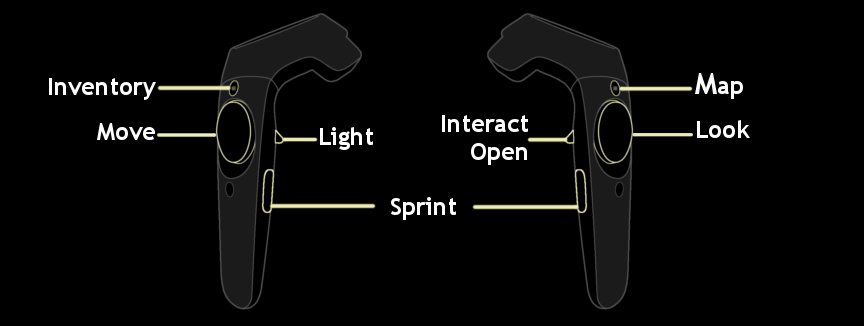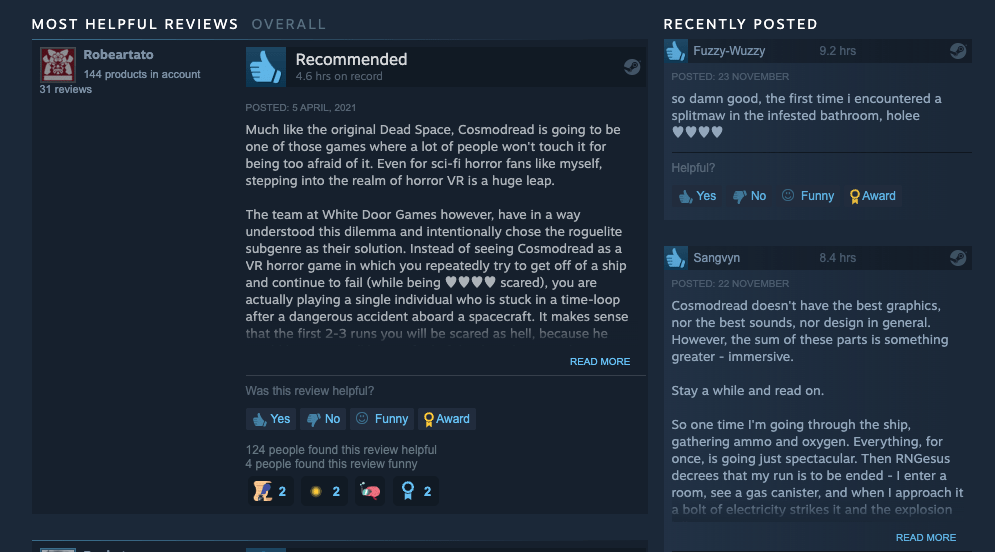
Building video games has never been a simple task. You can have a brilliant idea for a game, but without the right skills, tools and resources, it can be near-impossible to tackle by yourself. Especially if we consider something as complicated and new as virtual reality.
Not that this stopped Sergio Hidalgo. Being a one-man studio, Sergio managed to produce, release, and publish two successful VR titles. His first title, Dreadhalls, hit over 60,000 concurrent viewers on Twitch. (For comparison, Team Fortress 2’s highest was around 80,000.) While Cosmodread has had approximately 25,000 players on Steam alone and sold up to 250,000 units worldwide, across all major platforms. So to get his advice and learn his secrets, we sat down to hear his story and journey as a solo-game developer.
Here’s what he had to say.
1. You don’t have to have it all figured out
“I always wanted to make games – I even did small projects when I was a teen and carried on while studying computer science. But I didn’t enter the industry professionally until 2007, where I worked at a couple of small studios as a gameplay programmer. And I always had a side project on the go.”
Having a full-time job ate into Sergio’s personal dev time. It’s tricky to have enough energy to keep up with work, hobbies, friends, and life – let alone an entire game.
“One of my coworkers brought in their Oculus Rift DK1 one day. I loved it, and immediately ordered one for myself. And the timing was perfect. I just happened to start my vacation, which gave me enough time to experiment with it.
“Oculus was also running a game jam at the time, which I entered. And that resulted in the first prototype of Dreadhalls. It thankfully gained enough attention when I released it for free that I realized I could keep working on it and turn it into a full game. And so, I quit my job, and created White Door Games.”
There was never a master plan from day one. Sometimes, it’s about following your gut and what you enjoy.
2. You don’t have to start from scratch
Being a solo developer means you have very few resources to hand. So you need to be clever and use what you have wisely.
“Dreadhalls was the first VR game I made as White Door Games. It came from a project I had worked on when I was younger. A 2D, top-down stealth dungeon crawler. The player had no weapons, and had to sneak around to avoid detection.”

“So I had a game there. A good idea that I knew worked. I just had to translate it to a 3D environment. And when I played it in a VR headset, I realized just how scary it was. And I could use that to my advantage. I focused on the horror aspect to make it more engaging, and it pretty much designed itself after that. Just by asking, ‘what would make this scarier?’”
3. Build on your strengths
That doesn’t mean you shouldn’t take risks. But the same risks to a studio with a team, money and time are ten times greater to you. So it’s good to stick to what you know, and take it from there.
“I learned a lot from making Dreadhalls and all the feedback I got from players. And a lot of those lessons I carried over to my second game, Cosmodread. It’s another dungeoneering game at heart. But this time, I focused much more on the interactions and gameplay. I especially focused on having interactions that meshed well with hand-tracked controllers.”

Sergio’s first game, Dreadhalls, didn’t have such interactions. So rather than coming up with an entirely new concept for his second title, he stuck to his guns and layered in more elements – like in-game combat and the use of limited resources – to get people more engaged.
4. Understand the tech’s limitations
Technology is always evolving. And this is especially true with virtual reality. But the tech is still in its infancy, so there are limits to what you can do.
“Developing Dreadhalls was a challenge in itself. VR was in its early stages, so the platform was unstable. It’s progressed a lot, but there are still a lot of technical challenges. For example, the Oculus Quest is technically a mobile device, and so has limited power. It definitely puts a restraint on graphics, CPU use and stuff like that.”
It’s important to understand what limitations you’re working with. Otherwise, you could be facing more bugs, challenges, or a game that just won’t run well.
5. Put more focus on your design
“One of the biggest differences between VR and other devices was how similar to real-life VR is. And you need to have so much more thought when designing interactions for weapons and other gameplay elements. It’s much closer to real-life design than with more traditional games.”
A bad experience can put your players off. And even more so in VR, considering how immersive these games are compared to mobile, console and PC.
“You need to take into account things like ergonomics and hand placement. Items and weapons should be comfortable to use, and not put too much strain on the player and break their experience.”


“You even need to think about their height. If your environment doesn’t work for a taller or shorter person, or say an item is out of reach with a player with shorter arms, then you’re potentially alienating a big chunk of your player base. inclusivity is so important for VR. You should design for every body type, not just yourself.”
6. Get to know the VR market
“The VR market seems to exist as a separate entity from the main console and PC games. Especially with press outlets. Many traditional game websites simply won’t cover VR games at all, or only cover the major titles.”
This could be down to just how new the VR market is. And although it’s growing in size and popularity, it still has a long way to go when compared to its other types of gaming.
“So I try to target the few websites that specialize in VR content, plus social networks where the VR community gets its news from. The main storefronts (such as the Quest’s) are, of course, critical. So make sure you have a captivating trailer and gameplay footage.”
7. Don’t underestimate the power of your community
“When I launched Dreadhalls VR, I already had a nice following. I released a free early access version, which earned its place in the VR community. Streamers picked it up and created content around it, which gave me plenty of free publicity. When I finally released the full paid game, I had a lovely following to reach out to.”

It’s easy to be secretive and precious about your game. But the longer you wait to start talking about it, the harder it is to get the word out. Releasing a free version of your title can help you get the hype you need to climb the charts.
8. Figure out what you want to track early on
“Analytics was never really a priority during my development. But I would say if you’re thinking about analytics, then make sure you try and track anything to do with the player’s comfort. So which locomotion options your players prefer, how they use the controls, if they prefer sitting or standing. Anything to make their experience better and more immersive.”
It’s not just your game’s metrics you want to listen to. Sergio went on to say that any information he can get about his titles can help influence his decisions.
“I use the analytics from the different stores, which helped me figure out what languages to localize my game to, what promotions to apply, etc… But there’s also a lot to be said for listening to the players directly. Read reviews, watch gameplay videos by content creators, and listen to what they’re saying online.”
9. Make your games immersive and interactive
Unlike any other platform, your players are there, entering a new world, completely disconnected from reality. So you want to make it special.
“Focus on interactions. Encourage your players to manipulate the world around them. I used to believe a VR headset was like a teleportation machine, where it could take the player to a completely different world – and that you should focus on designing that place. But that’s just an incomplete idea.”
“The first thing your player will do is interact with the world in some way,” he added. “Whether that be by picking up objects or trying to open doors and so on. So you’ll want to support those natural interactions, and make the world feel more real. Reward their curiosity, surprise them, and make the whole experience more immersive.”
10. Give yourself some structure
“You need some structure if you’re working alone. You need to find some way to hold yourself accountable and try not to get distracted or demotivated. As you don’t have a team that relies on you, it’s much easier to procrastinate.”
Structure is only one part here. Sergio goes on to say that you need to know how to focus and prioritize, otherwise you could spend all your time on unimportant tasks.
“It’s very easy to fall into the trap of ‘productive procrastination’, where you spend a huge chunk of time on very specific features just because you enjoy working on them. You can end up ignoring more important parts of your game. You feel productive, but you’re actually wasting your most precious resource: time.
“Keep in mind, being a solo dev doesn’t mean you’re completely alone. Find someone you trust to bounce ideas off, or even just chat about your work. A fresh perspective always helps.”
11. Keep an ideas journal
Sergio’s last piece of advice is all about saving your ideas. Having an ideas journal means you always have a place to refer back to – whether you’re starting a new project or need fresh ideas for the one you’re buried in.
“Lastly, never throw away an idea. I have a long backlog of game ideas and concepts. Even ideas for environment settings and other design elements that come from random inspiration. This could be from other games, films, books, to simply just browsing artwork on websites like ArtStation.
“It’s good to have a gameplay-first approach. I always prototype the core gameplay first, and then tackle the environment, background story and all those other elements later. Cosmodread was supposed to take place in a suburban home. But I later switched it to a sci-fi setting, since it was a much better framework for some of the gameplay interactions I found interesting (like using battery cells to power rooms).”
That’s all from Sergio. If you have a spare moment or two, make sure to check out his games, Cosmodread and Dreadhalls. There’s plenty to learn from these two titles to help get your creative juices flowing.